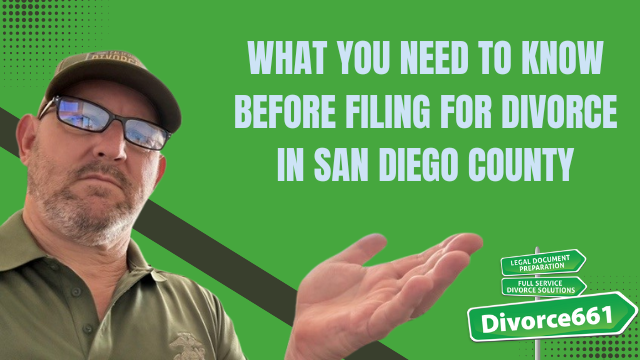What You Need to Know Before Filing for Divorce in San Diego County
Hi, I’m Tim Blankenship from Divorce661. If you’re thinking about filing for divorce in San Diego County, there are a few critical facts that can save you time, money, and stress. Below I’ll walk you through California’s no-fault divorce rules, residency and waiting-period requirements, the difference between uncontested and contested divorces, mandatory e-filing, the importance of financial disclosures, and how my team helped a couple finalize their divorce without ever going to court.
Quick Overview: The Essentials
- California is a no-fault divorce state — you don’t need to prove wrongdoing to file.
- San Diego County requires a mandatory six-month waiting period after the responding spouse is served.
- One party must have lived in San Diego County for at least three months before filing.
- Uncontested divorces are faster and far less expensive; contested cases can be lengthy and costly.
- E-filing is mandatory in San Diego County — mistakes can cause rejections and delays.
- Financial disclosures are required even when spouses agree — they protect both parties and prevent future disputes.
California’s No-Fault Divorce: What It Means for You
In California, you don’t have to prove fault—such as adultery or cruelty—to get a divorce. The court only needs a statement that the marriage has irretrievably broken down. This simplifies filing and shifts the focus to practical issues like property division, support, and parenting plans (if applicable).
Residency and the Six-Month Waiting Period
Before you file, make sure you meet San Diego County’s residency rule: one spouse must have lived in the county for at least three months. After the other spouse is served with divorce papers, there’s a mandatory six-month waiting period before the court can enter a final judgment. That waiting period is intended to give both parties time to finalize agreements or reconsider reconciliation.
Uncontested vs. Contested Divorce: Plan Your Path
How you proceed depends largely on whether you and your spouse can agree on the major issues:
- Uncontested Divorce: Both parties agree on terms—division of assets, debts, support, custody. This is the most efficient route: faster, cheaper, and often handled without attorneys or court appearances.
- Contested Divorce: Parties disagree on some or all issues. Court involvement is typical, and the process can become lengthy and expensive as mediation, hearings, and trial preparation take place.
Whenever possible, aim for an uncontested resolution. It reduces stress, preserves resources, and gives you more control over the outcome.
E-Filing: Mandatory and Exacting
San Diego County requires e-filing for divorce documents. That’s efficient, but it also means there’s little room for error. A single mistake — incorrect formatting, missing signatures, or incomplete information — can cause the county to reject your filing and create substantial delays.
If you choose to work with a service, make sure they’re experienced with San Diego’s e-filing system and the county’s procedural nuances. Accurate submissions matter.
Financial Disclosures: Don’t Skip Them
Even when you and your spouse are fully in agreement, California law requires financial disclosures. These disclosures—income, assets, debts, and expenses—ensure transparency and help protect both parties from future claims of hidden assets or surprise arrearages. Completing these documents thoroughly and honestly is essential to a clean, enforceable judgment.
“Financial disclosures are essential even if both parties agree on terms. They ensure transparency and fairness, preventing future disputes.”
A Real Case: How We Finalized a Divorce Without Court or Attorneys
At Divorce661 we guided a San Diego couple through a completely remote, no-court divorce. They were in full agreement, so we handled:
- Drafting and filing the petition
- Serving the responding spouse
- Preparing complete financial disclosures
- Submitting the final judgment
There were zero court appearances and no attorneys involved. The process was fast, clean, and court-approved. That’s the kind of outcome you can expect when matters are amicable and handled correctly from the start.
How Divorce661 Can Help
Our approach is designed for couples seeking an efficient, affordable divorce in San Diego County:
- Flat-fee pricing—no hourly surprises.
- 100% remote service—handle everything from your home.
- Expertise in e-filing and judgment submission to avoid rejections and delays.
- Guidance through disclosures and county requirements so your case is done right the first time.
Next Steps and Resources
- Confirm residency: make sure one spouse has lived in San Diego County for at least three months.
- Decide whether your divorce will be uncontested or contested.
- Prepare and exchange full financial disclosures—even if you agree on terms.
- Use an experienced e-filing service to reduce the risk of rejection.
- Consider a free consultation to review your situation and next steps.
If you’re ready to move forward or just want to discuss options, visit Divorce661.com to schedule a free consultation. Let’s make sure your divorce is done right the first time—seamless, stress-free, and fair.
Conclusion
Filing for divorce in San Diego County doesn’t need to be chaotic. Understanding California’s no-fault approach, the residency and waiting requirements, the difference between uncontested and contested cases, the mandatory e-filing process, and the necessity of financial disclosures will put you miles ahead. With the right help, you can complete an amicable divorce efficiently and avoid unnecessary court battles.
Visit Divorce661.com for a free consultation and practical guidance tailored to San Diego County divorce rules.

